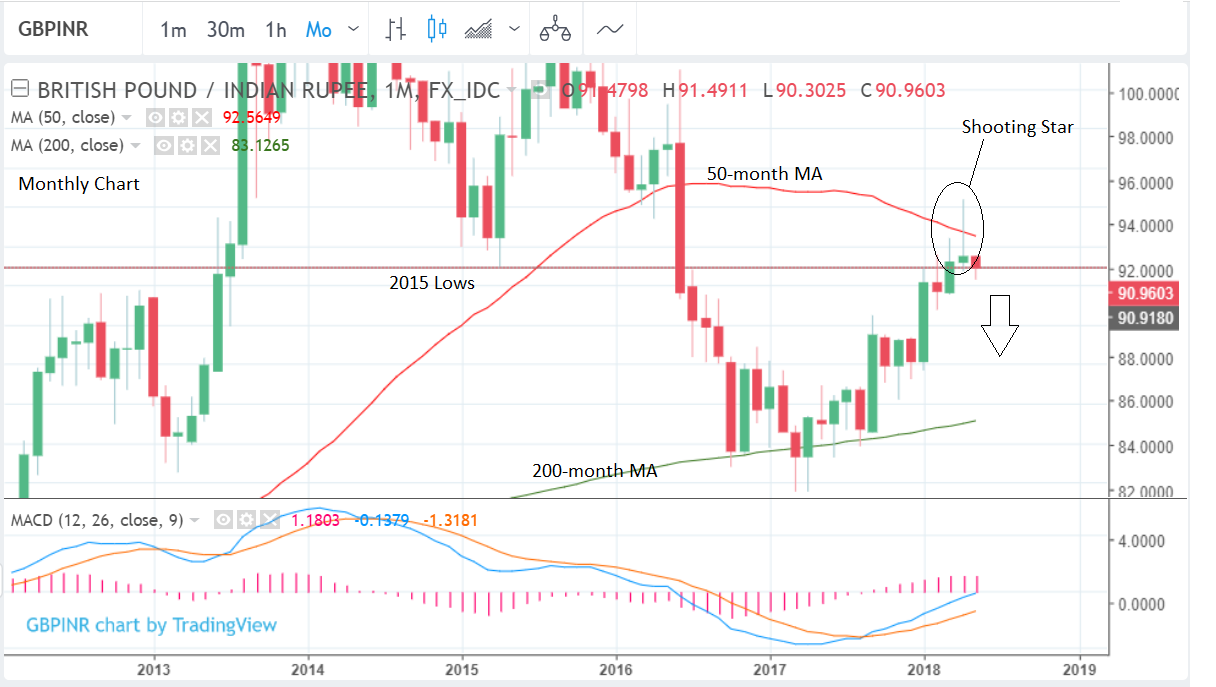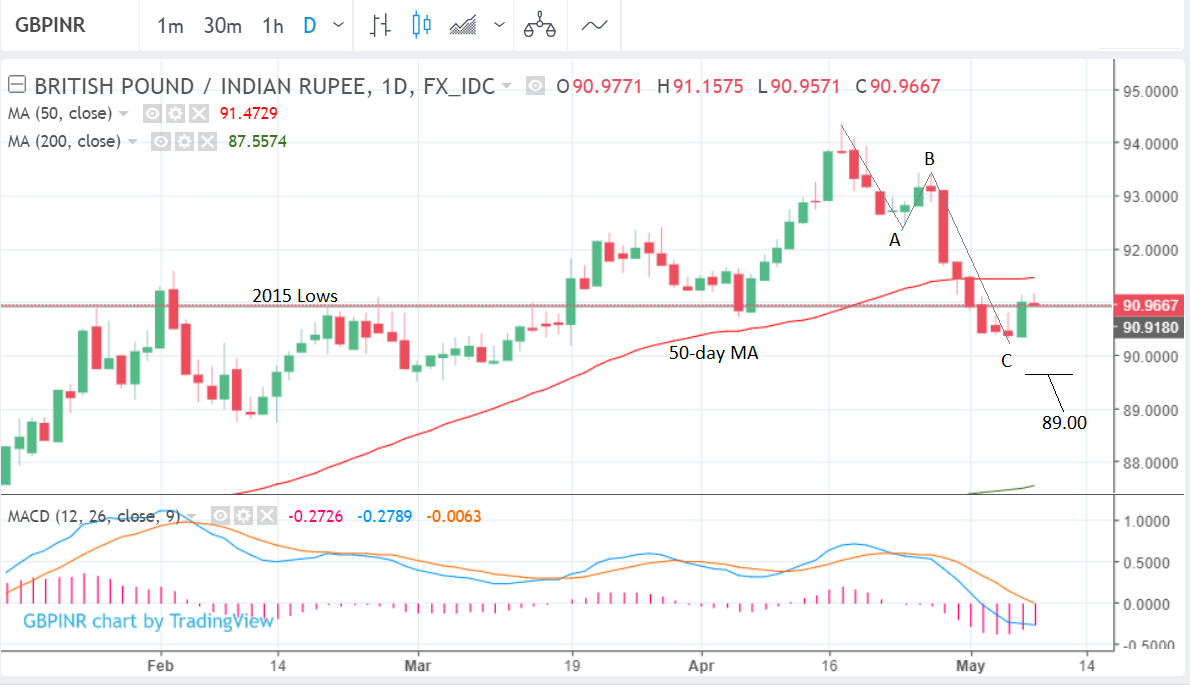The Pound-to-Rupee Rate's Forecast For the Week Ahead
- GBP/INR has weakened back down to the 90-91 Rupee level
- This week's highlight for Sterling is the Bank of England rate meeting on Thursday
- For the Rupee, industrial and manufacturing production data on Friday is the main release

© Goodpics, Adobe Stock
The Pound has weakened further versus the Rupee after the release of poor UK Services sector data increased concerns about a slowdown in growth in the economy in Q1.
Despite the Rupee facing its own fundamental headwinds - partly from rising oil prices which it has to import in large quantities, and partly from falling foreign investment - the pair has lost ground, falling by over a Rupee from the preceding week.
From a technical perspective, GBP/INR presents a more bearish picture: despite the medium-term uptrend, the pair has formed a bearish shooting star candlestick pattern on the monthly chart for April, which is a negative sign for the exchange rate.
The pattern gains confirmation if the following month is also bearish and so far this has been the case in May, and whilst we are far from the end of the month it's not a good early sign.
The location of the 50-month moving average (MA) intersecting the April highs at 92.74 suggests the MA is acting like a 'glass ceiling' and capping gains - a further bearish sign.
Very often this is the case with large MAs - they act as an impediment to further upside. This is because they are the locations of increased supply or demand due to more trading activity, owing to their popularity amongst investors.
The daily chart below also suggests a bearish outlook, albeit with some provisos.
The pair has pulled back after peaking at 94.34 on April 17, and it has so far penetrated further and more deeply than we previously imagined likely.
The pair has now broken below a key support zone composed of the 50-day MA and the 2015 lows situated in the 91 area of the chart, which we drew attention to in last week's analysis, here.
Because of this breakdown through these important support lines, we are not more bearish about the outlook for the pair.
The one proviso to our bearish view is that the pair has formed a fairly compelling three-wave ABC pattern in the process, which is a corrective chart-pattern suggesting the uptrend will resume once it is complete. ABC patterns usually complete when the wave's A and C are of an equal length; C now appears to be of greater length than A, suggesting the pattern could be ripe for heralding a reversal, and, indeed, the exchange rate has recovered marginally so far this week.
Of course, the fact wave C is longer than A could also be a sign the downtrend has force and vigour, and that the ABC may fail and the exchange rate could continue descending.
The problem for bears is that the 90 level is a key psychological level which may offer more support than usual as it could be the locus for increased buying and selling. In order to confirm more downside and an extension of the young bear tren, therefore, we would ideally wish to see a clear break below the 89.75, with an initial downside target from there at 89.00.
Get up to 5% more foreign exchange by using a specialist provider to get closer to the real market rate and avoid the gaping spreads charged by your bank when providing currency. Learn more here.
Data and Events to Watch for the Indian Rupee
The main data release for the Rupee in the week ahead is manufacturing and industrial production for March on Friday, May 11 at 13.00 GMT.
The consensus expectation amongst analysts is that industrial production is set to show a 6.3% rise from 7.1% increase at the same time a year ago.
A deeper-than-expected slowdown would probably impact negatively on the Rupee as it might suggest inflation could slow in the future, which would then lead to lower interest rates and a weaker Rupee.
Data and Events to Watch for the Pound
The main event in the week ahead for the Pound is the Bank of England (BOE) interest rate meeting on Thursday, May 10 at 12.00 GMT.
Whilst previously expectations had been for the BOE to raise interest rates by 0.25% at the meeting, data showing a slowdown in growth and commentary from the governor of the BOE, Mark Carney, which brought into question the necessity of a May hike, have dampened expectations more recently.
Official market expectations now stand at roughly 20% for a hike, and Sterling has decline alongside these fading expectations. A recent survey of economists held by Bloomberg found that none of them now expect a rate hike on Thursday.
Therefore - we would expect a substantial boost were the Bank to defy expectations and raise interest rates. In theory, the Pound could retrace much of the losses witnessed over recent weeks.
The BOE's inflation report is also out at the same time, and will show the Bank's latest forecasts for the economy and can provide insight into how the Bank may formulate policy in the future.
If it expects inflation and growth to rise, for example, that could be bullish for Sterling as it will imply more rate hikes, and higher interest rates are usually positive for a currency.
We would expect guidance to be important for Sterling - what does Carney's assessment of the recent growth slowdown, is it temporary or does he believe it to be more entrenched? Will the BOE confirm further interest rate rises are indeed necessary over coming weeks? These are where we see the big story for Sterling lying.
A more upbeat assessment of the economy and the outlook could certainly turn sentiment towards Sterling for the better, while a downbeat tone could allow the recent sell-off to extend.
"We expect clear evidence of a sustained rebound in GDP growth to pave the way for next rate hike to in November 2018, followed by two more hikes in 2019," says a preview note from Berenberg.
"Our baseline case is that next week will mark a three-month postponement to rate increases, with the next 25bp hike occurring in August," says Phillip Shaw, an economist from Investec.
Data releases are second-tier in nature. On Tuesday, May 08 at 8.30 large mortgage lender Halifax releases its house price index, which is forecast to show a decline of -0.3% month-on-month in April.
Wednesday sees the release of the British Retail Consortium's (BRC) Sales Monitor, which is forecast to show a -0.7% fall in April compared to April in 2017.
Thursday, May 10 sees the release of the Royal Institute of Chartered Surveyors (RICS) House Price balance just after midnight, which is expected to show a -1.0% fall in April.
Also out on Thursday is Industrial and Manufacturing Production at 9.30 with the former expected to show a 0.1% rise mom, and the latter a -0.2% decline.
Finally, the UK trade balance is out on Thursday and is forecast to show the trade deficit widening to -11.40bn in March.
Get up to 5% more foreign exchange by using a specialist provider to get closer to the real market rate and avoid the gaping spreads charged by your bank when providing currency. Learn more here.


